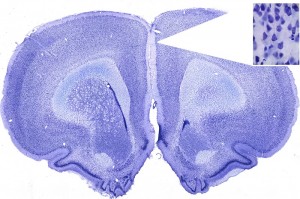
John Hopkins University Scientists Quantify Neurons with Stereo Investigator
Rats lose brain cells as they get older. But that doesn’t mean they can’t find their way through a water maze as quickly as their younger cohorts can.
Using unbiased stereology to quantify neurons in the prefrontal cortex of young and old rats, scientists at John Hopkins University in Baltimore found the total neuron number in the dorsal prefrontal cortex (dPFC) decreases with age. But despite the lost neurons, not all of the aged rats showed spatial learning impairment.
Led by Dr. Alexis Stranahan, the researcher team used Stereo Investigator with the Optical Fractionator to quantify total neuron number and the number of interneurons positively stained with antibodies to glutamic acid decarboxylase 67 (GAD67) in both the dorsal and ventral prefrontal cortex. They also used Stereo Investigator to outline cytoarchitectural boundaries in these regions of the rat brain.
To measure the efficiency of the rats’ spatial memory, the researchers used the Morris Water Maze. Trained to find a target platform while swimming in a pool of water, the rats were rated on their speed, distance traveled, and the time they spent in each area of the pool.
Their stereological analysis only revealed neuron count changes in the dPFC. No changes were observed in the vPFC; “and age-related neuronal loss was not associated with spatial memory performance,” the authors state in their paper, which was published online last February in the Journal of Comparative Neurology and will appear in the April 15 issue.
“We believe that when these data are taken together with the current observation that both aged-impaired and aged-unimpaired rats exhibit decreased neuron number in the dorsal prefrontal region, to the extent that such neuron loss is detrimental in this behavioral model, some compensatory mechanisms might be recruited to maintain the performance of unimpaired rats,” according to the study.
Read the full paper here.
Reference:
Stranahan, A. M., N. T. Jiam, A. M. Spiegel and M. Gallagher (2012). “Aging reduces total neuron number in the dorsal component of the rodent prefrontal cortex.” The Journal of Comparative Neurology 520(6): 1318-1326.



